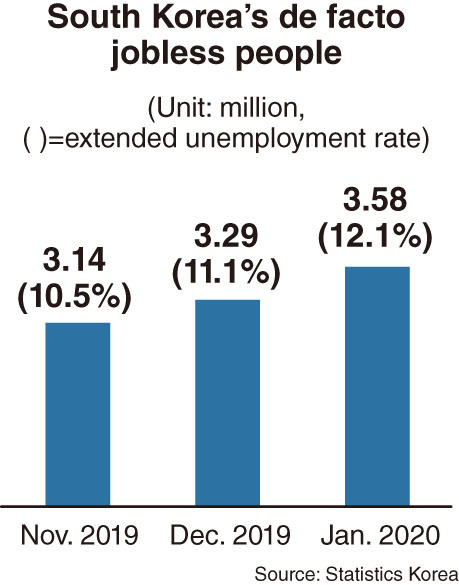[News Focus] Number of de facto jobless up 440,000 in 2 months
By Kim Yon-sePublished : Feb. 20, 2020 - 16:52

SEJONG -- South Korea saw the number of de facto jobless people -- meaning those underemployed -- increase sharply in recent months, the latest data showed.
According to Statistics Korea, the “extended (or sentiment-reflected)” unemployment rate climbed to 12.1 percent in January 2020.
The figure indicates that 3.58 million of the extended economically active population of 29.65 million are de facto unemployed. This far exceeds the nation’s official jobless rate (4.1 percent) and the number of jobless people (1.15 million) as of last month.
The portion of de facto jobless people showed a steep growth from and 10.5 percent in November and 11.1 percent in December.

Compared with two months earlier, the number of de facto unemployed Koreans surged by 440,000 in January from 3.14 million in November.
The extended jobless rate, which reflects the people who are underemployment as well as unemployed, is tabulated in Statistics Korea’s Supplementary Index III for Employment.
People deemed to be among the extended unemployed include temporary employees who work fewer than 36 hours a week and want to work more hours, as well as seasonal workers who are out of work for part of the year.
“The extended unemployment rate reached above 12 percent for the first time in eight months since May 2019. This could mean job creation, pushed by the government, resulted in mostly unstable, temporary jobs,” said a recruitment industry worker in Seoul.
He also said the government’s all-time high payouts for those, who lost jobs, tells that conditions in the regular-job market are yet to improve despite a series of supplementary budgets allocated for raising employment.
Further, the January figure is also higher than 10.9 percent (3.23 million jobless people), posted in May 2017, when the Moon Jae-in administration took office.
The Organization for Economic Cooperation and Development has unveiled the fourth-quarter figures, the latest available, for employment rates of its 36 members. The employment rate measures employment as a proportion of the working age population -- those aged between 15 and 64.
Korea was ranked 28th in the employment-rate ranking, with 67.1 percent as of December. This falls behind the OECD average of 68.9 percent.
The country also ranked below both the average of 19 eurozone countries (67.9 percent), 28-member European Union (69.3 percent), and the G-7 countries (72 percent).
Among those, ranked above Korea were Slovakia (25th) at 68.4 percent, Ireland (23rd, 69.3 percent), Hungary (22nd, 70.1 percent), Lithuania (17th, 72.9 percent) and Estonia (9th, 73.5 percent).
Japan ranked 4th with 78.1 percent, followed by New Zealand (5th, 77.3 percent), Sweden (6th, 77 percent) and Germany (7th, 76.8 percent). Iceland topped the list with 82.7 percent, trailed by Switzerland (2nd, 80.5 percent) and Netherlands (3rd, 78.2 percent).
The UK and the US also stayed above the OECD average with 75 percent and 71.7 percent, respectively.
More seriously, Korea was far behind in the youth employment rate for those aged between 15 and 24. While the OECD member countries’ average was 42.3 percent, Korea’s employment rate for the age group stood at 27 percent as of December.
Japan’s average for this age group stood at 47.9 percent and the US’ was 51.6 percent. Mexico and Israel posted 41.7 percent and 41.6 percent, respectively.
Korea ranked 31st of the OECD members in the youth employment. While Iceland topped the list at 69.1 percent, the average for the youth employment of the G-7 countries was 46.4 percent.
By Kim Yon-se (kys@heraldcorp.com)






![[KH Explains] How should Korea adjust its trade defenses against Chinese EVs?](http://res.heraldm.com/phpwas/restmb_idxmake.php?idx=644&simg=/content/image/2024/04/15/20240415050562_0.jpg&u=20240415144419)











![[Today’s K-pop] Stray Kids to return soon: report](http://res.heraldm.com/phpwas/restmb_idxmake.php?idx=642&simg=/content/image/2024/04/16/20240416050713_0.jpg&u=)